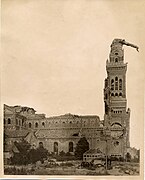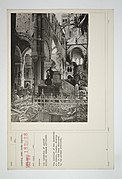The Golden Virgin
 The Golden Virgin Sculpture atop the Basilica
[A] | |
 Location in France | |
| Coordinates | 50°00′13″N 2°38′53″E / 50.003611°N 2.648056°ECoordinates: 50°00′13″N 2°38′53″E / 50.003611°N 2.648056°E |
|---|---|
| Location | 20 Rue Anicet Godin, 80300 Albert, France |
| Designer | Albert Roze |
| Material | Metal |
| Height | 5 m (16 ft 5 in)[1] |
| Completion date | 1897 |
| Dedicated to | The Virgin Mary |
The Golden Virgin, a/k/a 'The Leaning Virgin'[B] is a gilded sculpture depicting the Virgin Mary offering up the Baby Jesus skyward. Standing atop of the Basilique Notre-Dame de Brebières (French) Basilica of Our Lady of Brebières, a Catholic Church in Albert, France, it was sculpted by Albert Roze. After being nearly toppled by shellfire in the Battle of the Somme,[C] it became a symbol of resilience and a great visual icon during World War I. The statue was damaged and leaning in 1915 and went missing when it finally fell in 1918 as a result of the ultimate British bombardment.[3][4] It was recast and replaced thereafter.
Materials[]
The sculpture was covered with thousands of gold leaves. Pope Leo XIII christened the church and seeing the Golden Virgin he called the basilica “Lourdes of the North.” The sculpture was fastened to the bell tower.[5] When the statue was leaning after 2000 shells hit the town and Basilica in 1915.[5] French engineers fastened a chain to keep her from falling to open area below.[6] Other sources say it was either the British or the French who secured the statue with a thick cable.[4]
Background[]

In 1915 during The Battle of the Somme, World War I, the sculpture was shelled and leaning past 90 degrees.[2][7]
In 1914 the Germans suspected there was a French observation post in the bell tower, so beginning in October 1914 they shelled the dome. By January 7, 1915, the dome was destroyed and by January 21, 1915, the base of the statue was hit and the statue "tilted alarmingly".[8] The sculpture was designed by French sculptor Albert Roze and in 1897 and it was placed atop the Basilique Notre-Dame de Brebières. The sculpture depicts a golden colored Virgin Mary holding the infant Christ high above her head. Artillery shells destroyed much of the town of Albert, but the statue of Mary remained attached to the Basilica and badly tilted.[7]

Superstitious soldiers studied the sculpture daily - wrote about her in their diaries and remarked that she was knocked over... threatening to fall over at any time. The messages about the statue were passed between troops, and it was often said that “When the Virgin falls, the war will end.”. Soldiers also said whomever knocked the statue down would lose the war.[D][5][7]
The statue became a symbol to British and German troops as soldiers remarked that the Virgin Mary was keeping the baby Christ from falling.[10] By 1918 the German troops occupied the city of Albert, and the British shelled the Basilique to deprive the Germans of the high position, and the statue finally was toppled. The statue was never recovered.[1] Coincidentally, WWI ended November 11, 1918.[11]
Residents discussed placing the sculpture in her famous war-time pose. They eventually decided to place her in her original standing pose.[1] The sculpture of the Golden Virgin was recast 1929[5] and fitted atop the 76 m (249 ft 4 in) bell tower during the reconstruction of the Basilica.[12]
The photo of leaning virgin was a fascination for many, and soldiers took photos: it appeared on many postcards at the time.[2][9] The actions of French engineers in shoring it up continue to be a source of amazement. Over one hundred years later, it remains a symbol and metaphor for the triumph of good over evil.[13]
The Golden Virgin and "flying baby" statue was recast and placed upon the reconstructed bassilica.[14]
In 1957, and thereafter in many subsequent editions, the events surrounding the church and its sculpture were the subject of a popular novel by Henry Williamson, titled The Golden Virgin, being Volume 6 of the A Chronicle of Ancient Sunlight series. It was selected as a Daily Mail Book of the Month. [15]

1915-1917, Havoc of War - Ruins - France - Cities - A - Church of Notre Dame at Albert, France - War Department

1914–1917, Daily Mail Official War Photograph, "The Church at Albert". "Passed by Censor" and "The Germans bombardment caused this strange bending downwards of the Virgin and Child on Albert Church tower."

1915, View of the ruins of the Basilica of Notre-Dame de Brebières in Albert

1917, Item is a photograph from an album of World War One-related photographs in the William Okell Holden Dodds fonds. Brigadier General Dodds

1918, Side view of the heavily bomb-damaged La Basilique in the city of Albert, France

8/1918, British cavalry passing the ruins of Albert cathedral, France, during World War I

1918, Photograph from an album of World War One-related photographs in the William Okell Holden Dodds fonds

1914-1917 Havoc of War Ruins France Cities Cathedral ruined by German Artillery

1914-1918 Soldiers in front of the Notre-Dame de Brebières Basilica in Albert
See also[]
- Basilique Notre-Dame de Brebières French Wikipedia
- Christian symbolism
- Golden Madonna of Essen
- Mariology
- Monument
- Religious art
- Roman Catholic Marian art
- Sculpture
References[]
Notes[]
- ^ Basilique Notre-Dame de Brebières with The Golden Virgin atop of the bell tower. The sculpture was created by Albert Roze and subsequently destroyed and lost during World War I.
- ^ "Most Tommies called it the ‘Leaning Virgin’ or the ‘Golden Virgin’. When the Australians arrived in July 1916 they had another name for it – Fanny Durack ... an Australian female olympic swimmer who had won a gold medal in the 1912 Olympics. The Diggers thought it looked like Fanny diving into a swimming pool!"[2]
- ^ "The Battle of the Somme was fought from north of the Somme river between the towns of Albert and Arras. The Battle began on the 1 July and was called off on the 18 November 1916. The Battle of the Somme is famous for the loss of 58,000 British troops (one third of them killed) on the first day of the battle, 1 July 1916, which to this day remains a one-day record."[3]
- ^ "No one wanted it to remain what it literally was, merely an accidentally damaged third-rate gilded metal statue now so tenuously fixed to its tower that it might fall any moment. Myth busily attached portentous meaning to it."[9]
Citations[]
- ^ a b c Holt, Tonie; Holt, Valmai (2016). Somme 100th Anniversary. Yorkshire, England: Pen & Sword Books. p. 368. ISBN 9781473866744. Retrieved October 13, 2021.
- ^ a b c Reed, Paul. "WW1 Landmarks: The Leaning Virgin, Albert". Retrieved October 15, 2021.
- ^ a b "Item MM 120129 Photograph - 'Basilica of Notre-Dame de Brebières', Albert, France, Sergeant John Lord, World War I, 1916". Museums Victoria. Retrieved October 15, 2021.
- ^ a b Aonghais, Clinton Mhic (2014). The Baker Boys. Bloomington, Indiana: Trafford Publishing. p. 380. ISBN 978-1-4907-3909-0. Retrieved October 13, 2021.
- ^ a b c d Daubs, Katie (October 15, 2018). "'When the Virgin falls, the war will end'". Toronto Star. Retrieved October 13, 2021.
- ^ Middlebrook, Martin (April 1, 2018). The First Day on the Somme: 1 July 1916. London England: Penguin Publishing. ISBN 978-0141981604. Retrieved October 13, 2021.
- ^ a b c Walsh, Michael (September 30, 2011). Brothers in War. London, United Kingdom: Ebury Publishing. p. 177. ISBN 9781446446157. Retrieved October 13, 2021.
- ^ Sumner, Ian (2018). The French Army on the Somme 1916. Great Britain: Pen and Sword Military. ISBN 978-1-52672-548-6. Retrieved October 13, 2021.
- ^ a b Fussell, Paul; Winter, J.M. (June 12, 2013). "Myth, Ritual, and Romance". The Great War and Modern Memory (Paperback) (New ed.). New York, New York: Oxford University Press. pp. 131–35. ISBN 9780199971954.
- ^ Neiberg, Michael S. (February 16, 2014). The Western Front 1914–1916. Oxford, United Kingdom: . p. 39. ISBN 9781908273109. Retrieved October 13, 2021.
- ^ "Armistice Day: World War I ends". History. A&E Television Networks. Retrieved October 13, 2021.
- ^ David, Samantha (March 2, 2021). "€180million facelift for WW1 bombarded French basilica". The Connexion. English Language Media. Retrieved October 12, 2021.
- ^ Part-time Priest (November 7, 2015), Sermon: The Leaning Virgin
- ^ "Basilique Notre-Dame de Brebières, Albert, France". Retrieved October 14, 2021.
A graceful building, topped with a golden Virgin and "flying baby."
- ^ "The Golden Virgin (Vol. 6, A Chronicle of Ancient Sunlight)". The Henry Williamson Society. Retrieved October 14, 2021.
,
External links[]
- Museum Victoria photo of the leaning Virgin
- Visit Somme website
- WWI Landmarks
- Stock photograph, The Leaning Virgin of Albert, France, A WW1 legend Photograph
- Stock photograph, Albert, Picardy, France. Golden Virgin atop steeple of Basilica of Notre Dame de Brebieres after being hit by German shellfire
- Outdoor sculptures in France
- Statues in France
- 19th-century sculptures
- 20th-century sculptures
- Religious sculptures
- Catholic sculpture
- Statues of the Madonna and Child










